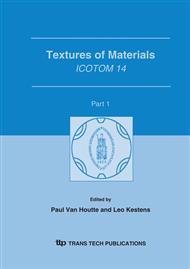p.1639
p.1645
p.1653
p.1657
p.1665
p.1675
p.1681
p.1687
p.1693
Determination of Morphological Textures of the Fibres in Composite Materials Made from Textiles of Carbon Fibres
Abstract:
The orientation distribution of fibres (morphological texture) in a composite is very important in determining the properties of the material. Therefore, methods which can provide quantitative descriptions of the morphological texture are essential. One approach to determining the morphological texture function (MTF) is to measure the orientation distribution of the crystals in the fibres. Since many types of reinforcing fibres are crystalline and textured (i.e. carbon fibres, whiskers, etc.) this approach may be interesting for commercial/industrial applications. For this technique to be applied, the crystallographic texture intrinsic to the fibres must be determined and subsequently measurements of the crystallographic texture should be made in the composite. The morphological texture can then be calculated by a deconvolution of the composite texture with the fibre’s intrinsic texture. In this paper, morphological textures are determined in woven fabrics made from carbon fibres embedded in a polymer matrix. Straight fibres removed from the fabric serve as the reference material for the deconvolution. It is demonstrated that this technique is applicable and can resolve the orientation distribution to an accuracy greater than is needed for determining the elastic properties.
Info:
Periodical:
Pages:
1675-1680
Citation:
Online since:
September 2005
Authors:
Keywords:
Price:
Сopyright:
© 2005 Trans Tech Publications Ltd. All Rights Reserved
Share:
Citation:


